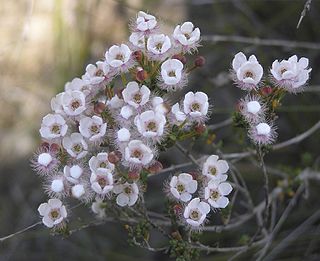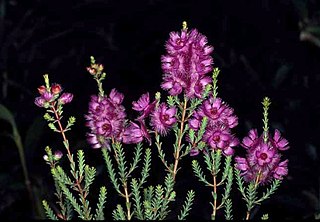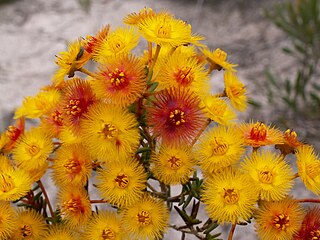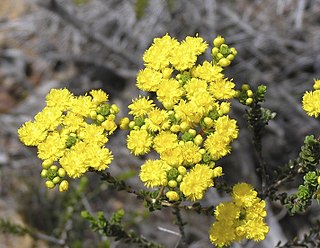
Verticordia plumosa, commonly known as plumed featherflower, is a flowering plant in the myrtle family, Myrtaceae and is endemic to the south-west of Western Australia. It was the first species in the genus to be described, although initially given the name Chamelaucium plumosum. It is a shrub with linear leaves and rounded groups of scented pink, mauve or white flowers. Two varieties of this species have been declared as being "threatened".
Verticordia crebra, commonly known as Barrens featherflower, crowded featherflower or Twertup featherflower, is a flowering plant in the myrtle family, Myrtaceae and is endemic to the south-west of Western Australia. It is a sprawling shrub with crowded, cylinder-shaped leaves with small, yellow flowers that are almost hidden by the leaves but with a style which extends well beyond the petals. The plant looks superficially like a miniature pine tree.

Verticordia cunninghamii, commonly known as tree featherflower or liandu, is a flowering plant in the myrtle family, Myrtaceae and is endemic to an area in the extreme north of Western Australia and the Northern Territory. It is a spindly shrub or small tree with narrow leaves and cream to white, sweetly scented, feathery flowers.

Verticordia habrantha, commonly known as hidden featherflower, is a flowering plant in the myrtle family, Myrtaceae and is endemic to the south-west of Western Australia. It is a slender shrub with short, leafy side-branches and long flowering stems with rounded heads of mostly white flowers. Its hairy sepals are mostly hidden by the round, unfringed petals, and as a result, the plant looks like shrubs in the genus Chamelaucium, to which it is closely related.

Verticordia helichrysantha, commonly known as coast featherflower or Barrens featherflower, is a flowering plant in the myrtle family, Myrtaceae and is endemic to the south-west of Western Australia. It is a small, woody, open-branched shrub with crowded, linear leaves and small yellow flowers from May to September.
Verticordia sect. Verticordia is one of eleven sections in the subgenus Verticordia. It includes eight species of plants in the genus Verticordia. Plants in this section are open to bushy shrubs up to 1 m (3 ft) tall with needle-like leaves, feather-like sepals and anthers opening by slanting pores. When Johannes Conrad Schauer described other subgenera in Verticordia, subgenus Verticordia became an autonym after Augustin de Candolle who described the genus in 1828. When Alex George reviewed the genus in 1991, he took the name of this section from that of the subgenus.
Verticordia sect. Chrysoma is one of seven sections in the subgenus Chrysoma. It includes four species of plants in the genus Verticordia. Plants in this section are small shrubs with small, bright yellow flowers which usually turn red as they age. They have sepals with fringed lobes and petals which have lobes arranged like the fingers of a hand. The subgenus Chrysoma was originally described in 1843 by Johannes Conrad Schauer and the description was published in Monographia Myrtacearum Xerocarpicarum. When Alex George reviewed the genus in 1991, he took the name of this section from that of the subgenus.

Verticordia is a genus of more than 100 species of plants commonly known as featherflowers, in the myrtle family, Myrtaceae. They range in form from very small shrubs such as V. verticordina to trees like V. cunninghamii, some spindly, others dense and bushy, but the majority are woody shrubs up to 2.0 m (7 ft) tall. The flowers are variously described as "feathery", "woolly" or "hairy" and are found in most colours except blue. They often appear to be in rounded groups or spikes but in fact are always single, each flower borne on a separate stalk in a leaf axil. Each flower has five sepals and five petals all of a similar size with the sepals often having feathery or hairy lobes. There are usually ten stamens alternating with variously shaped staminodes. The style is simple, usually not extending beyond the petals and often has hairs near the tip. All but two species are found in Southwest Australia, the other two occurring in the Northern Territory.

Verticordia densiflora, commonly known as compacted featherflower, is a flowering plant in the myrtle family, Myrtaceae and is endemic to the south-west of Western Australia. It is a shrub with small leaves, usually small pink and white flowers and which is widespread in the south-west of the state. It is a variable species and in his 1991 paper, Alex George formally described five varieties.
Verticordia densiflora var. cespitosa is a flowering plant in the myrtle family, Myrtaceae and is endemic to the south-west of Western Australia. It is a shrub with small leaves and pink, or pink and white flowers. It is one of five varieties of the species Verticordia densiflora.

Verticordia drummondii, commonly known as Drummond's featherflower, is a flowering plant in the myrtle family, Myrtaceae and is endemic to the south-west of Western Australia. It is an erect, openly to densely branched shrub with small, narrow leaves and pink to purple flowers in small heads near the ends of the branches.

Verticordia endlicheriana is a flowering plant in the myrtle family, Myrtaceae and is endemic to the south-west of Western Australia. It is a shrub with narrow leaves and yellow flowers which in some varieties age to red. It is a variable species and in his 1991 paper, Alex George formally described five varieties.

Verticordia etheliana is a flowering plant in the myrtle family, Myrtaceae and is endemic to the south-west of Western Australia. It is a shrub with one highly branched main stem, egg-shaped to almost round leaves and spike-like groups of bright red flowers with greenish-cream centres.
Verticordia huegelii var. stylosa, commonly known as variegated featherflower, is a flowering plant in the myrtle family, Myrtaceae and is endemic to the south-west of Western Australia. It is a single-stemmed shrub with its growth form depending on its surroundings. It is similar to other varieties of the species but differs in its flower colour and the form of the style and staminodes.
Verticordia lepidophylla is a flowering plant in the myrtle family, Myrtaceae and is endemic to the south-west of Western Australia. It is usually a bushy shrub with small leaves and spikes of creamish-green to yellow flowers in spikes along the branches in late spring to early summer.

Verticordia lindleyi is a flowering plant in the myrtle family, Myrtaceae and is endemic to the south-west of Western Australia. It is sometimes an openly branched shrub, other times more or less dense, with small leaves and spreading, spike-like groups of pink or purple flowers along the stems in summer, sometimes also in autumn.
Verticordia multiflora is a flowering plant in the myrtle family, Myrtaceae and is endemic to the south-west of Western Australia. It is a small, openly branched shrub with small leaves and groups of scented, bright yellow flowers on the ends of the branches in spring or early summer.

Verticordia serrata is a flowering plant in the myrtle family, Myrtaceae and is endemic to the south-west of Western Australia. It is a spindly or openly branched shrub with hairy, egg-shaped leaves and flowers which are golden at first, then fade to a greyish colour.
Verticordia stenopetala is a flowering plant in the myrtle family, Myrtaceae and is endemic to the south-west of Western Australia. It is a low shrub with small leaves and heads of pink to magenta-coloured flowers in late spring and early summer.
Verticordia sect. Catocalypta is one of eleven sections in the subgenus Verticordia. It includes seven species of plants in the genus Verticordia. Plants in this section are small, bushy shrubs which grow to a height of up to 1 m (3 ft), have thick, fleshy, leaves which are triangular in cross-section. The flowers are arranged in open, corymb-like heads of relatively large flowers. Importantly, their sepals have down-turned, tufts of hair which surround the floral cup.









